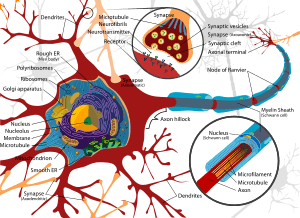
Computers will help people to understand brains better. And understanding brains will help people to build better computers
ANALOGIES change. Once, it was fashionable to describe the brain as being like the hydraulic systems employed to create pleasing fountains for 17th-century aristocrats’ gardens. As technology moved on, first the telegraph network and then the telephone exchange became the metaphor of choice. Now it is the turn of the computer. But though the brain-as-computer is, indeed, only a metaphor, one group of scientists would like to stand that metaphor on its head. Instead of thinking of brains as being like computers, they wish to make computers more like brains. This way, they believe, humanity will end up not only with a better understanding of how the brain works, but also with better, smarter computers.
These visionaries describe themselves as neuromorphic engineers. Their goal, according to Karlheinz Meier, a physicist at the University of Heidelberg who is one of their leaders, is to design a computer that has some—and preferably all—of three characteristics that brains have and computers do not. These are: low power consumption (human brains use about 20 watts, whereas the supercomputers currently used to try to simulate them need megawatts); fault tolerance (losing just one transistor can wreck a microprocessor, but brains lose neurons all the time); and a lack of need to be programmed (brains learn and change spontaneously as they interact with the world, instead of following the fixed paths and branches of a predetermined algorithm).
To achieve these goals, however, neuromorphic engineers will have to make the computer-brain analogy real. And since no one knows how brains actually work, they may have to solve that problem for themselves, as well. This means filling in the gaps in neuroscientists’ understanding of the organ. In particular, it means building artificial brain cells and connecting them up in various ways, to try to mimic what happens naturally in the brain.
Analogous analogues
The yawning gap in neuroscientists’ understanding of their topic is in the intermediate scale of the brain’s anatomy. Science has a passable knowledge of how individual nerve cells, known as neurons, work. It also knows which visible lobes and ganglia of the brain do what. But how the neurons are organised in these lobes and ganglia remains obscure. Yet this is the level of organisation that does the actual thinking—and is, presumably, the seat of consciousness. That is why mapping and understanding it is to be one of the main objectives of America’s BRAIN initiative, announced with great fanfare by Barack Obama in April. It may be, though, that the only way to understand what the map shows is to model it on computers. It may even be that the models will come first, and thus guide the mappers. Neuromorphic engineering might, in other words, discover the fundamental principles of thinking before neuroscience does.
Two of the most advanced neuromorphic programmes are being conducted under the auspices of the Human Brain Project (HBP), an ambitious attempt by a confederation of European scientific institutions to build a simulacrum of the brain by 2023. The computers under development in these programmes use fundamentally different approaches. One, called SpiNNaker, is being built by Steven Furber of the University of Manchester. SpiNNaker is a digital computer—ie, the sort familiar in the everyday world, which process information as a series of ones and zeros represented by the presence or absence of a voltage. It thus has at its core a network of bespoke microprocessors.
The Latest Bing News on:
Neuromorphic computing
- Neuromorphic Chip Market Size To Touch $2734.8 Million By 2031 Driven By Industrial Adoption And Big Data Analysison May 8, 2024 at 10:46 pm
Neuromorphic chips offer a revolutionary approach to computing by mimicking the human brain's structure and function. These chips leverage spiking neural networks (SNNs) that emulate the biological ...
- SpiNNcloud Systems Unveils Innovative Neuromorphic Supercomputer SpiNNaker2on May 8, 2024 at 3:45 pm
SpiNNcloud System has revealed their revolutionary SpiNNaker2 platform which is a new hybrid AI supercomputer based on principles from the human brain as a next generation machine. Developed by Steve ...
- Neuromorphic supercomputer SpiNNaker 2 can be rented in the cloudon May 8, 2024 at 12:15 pm
SpiNNcloud Systems offers access to up to 656,640 economical CPU cores with accelerators that calculate up to 0.3 quintillion operations per second.
- BrainChip Adds Penn State to Roster of University AI Acceleratorson May 8, 2024 at 9:48 am
BrainChip’s University AI Accelerator Program provides platforms and guidance to students at higher education institutions with AI engineering programs. Students participating in the program have ...
- SpiNNcloud Systems launches SpiNNaker2, the first commercial neuromorphic supercomputeron May 8, 2024 at 6:36 am
German neuromorphic supercomputing company SpiNNcloud Systems GmbH today announced the first commercially available neuromorphic supercomputer with the launch of its SpiNNaker2 pl ...
- 'Inspired by the human brain': Intel debuts neuromorphic system that aims to mimic grey matter with a clear aim — making the machine exponentially faster and much more power ...on April 27, 2024 at 10:40 pm
Intel's Hala Point is the world's largest “brain-based” computing system with 1.15 billion artificial neurons.
- Scientists use salt, water to prove human brain-like computer can existon April 26, 2024 at 4:13 am
The artificial synapse known as an iontronic memristor functions as a microchannel filled with a solution of water and salt.
- Intel builds world’s largest neuromorphic systemon April 17, 2024 at 5:00 pm
Meanwhile, another new technology is poised to make a much more immediate difference: neuromorphic computing. Neuromorphic computing looks to redesign how computer chips are built by looking at ...
- Intel unveils largest-ever AI 'neuromorphic computer' that mimics the human brainon April 17, 2024 at 5:00 pm
Intel's Hala Point neuromorphic computer is powered by more than 1,000 new AI chips and performs 50 times faster than equivalent conventional computing systems. Scientists at Intel have built the ...
- Intel unveils Hala Point, its second-generation neuromorphic computing systemon April 17, 2024 at 1:00 am
This deployment is part of a relationship between the two parties that goes back to 2021 to explore neuromorphic computing in AI further. “The computing cost of today’s AI models is rising at ...
The Latest Google Headlines on:
Neuromorphic computing
[google_news title=”” keyword=”Neuromorphic computing” num_posts=”10″ blurb_length=”0″ show_thumb=”left”]
The Latest Bing News on:
Neuromorphic engineering
- Mapping brain function, safer autonomous vehicles are focus of Schmidt Transformative Technology fundon May 8, 2024 at 1:05 pm
Two projects — one that maps the function of the brain’s neuronal network in unprecedented detail and another that combines robotics and light-based computer circuits to create safe self-driving ...
- BrainChip Adds Penn State to Roster of University AI Acceleratorson May 8, 2024 at 9:48 am
BrainChip’s University AI Accelerator Program provides platforms and guidance to students at higher education institutions with AI engineering programs. Students participating in the program have ...
- Engineering Newson May 5, 2024 at 5:00 pm
Apr. 29, 2024 — For the first time, the state of an atomic nucleus was switched with a laser. For decades, physicists have been looking for such a nuclear transition -- now it has been found ...
- Scientists use salt, water to prove human brain-like computer can existon April 26, 2024 at 4:13 am
The artificial synapse known as an iontronic memristor functions as a microchannel filled with a solution of water and salt.
- Studying optimization for neuromorphic imaging and digital twinson April 18, 2024 at 5:00 pm
Significant impact is expected on Air Force, Space Force (imaging, object tracking), Civil Engineering (structures such as bridges), Machine Learning (neuromorphic computing), etc. Mason will host ...
- Intel's Hala Point, the world's largest neuromorphic computer, has 1.15 billion neuronson April 18, 2024 at 7:37 am
The Hala Point system's 1,152 Loihi 2 chips enable a total of 1.15 billion artificial neurons, Intel said, "and 128 billion synapses distributed over 140,544 neuromorphic processing cores." That is an ...
- Intel reveals world's biggest 'brain-inspired' neuromorphic computeron April 17, 2024 at 8:30 am
"I mean, there wasn't any particular technical engineering challenge that made us stop at this level." No other existing machine comes close to the scale of Hala Point, although DeepSouth, a ...
- Intel unveils brain-inspired neuromorphic chip system for more energy-efficient AI workloadson April 17, 2024 at 8:00 am
Neuromorphic computing is an entirely new ... in areas such as real-time continuous learning for scientific and engineering problem-solving AI applications. Other potential use cases include ...
- Intel reveals world's biggest 'brain-inspired' neuromorphic computeron April 16, 2024 at 5:01 pm
but experts say there are engineering hurdles to overcome before the device can compete with the state of the art, let alone exceed it. Expectations for neuromorphic computers are high because ...
The Latest Google Headlines on:
Neuromorphic engineering
[google_news title=”” keyword=”Neuromorphic engineering” num_posts=”10″ blurb_length=”0″ show_thumb=”left”]









